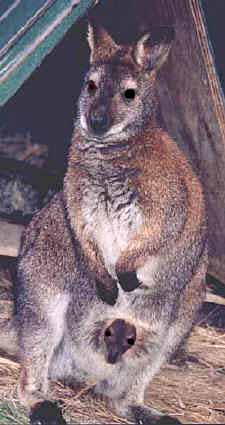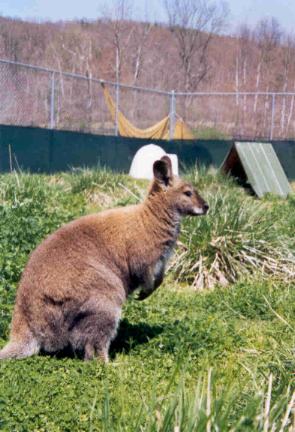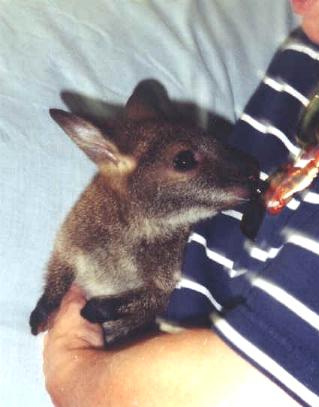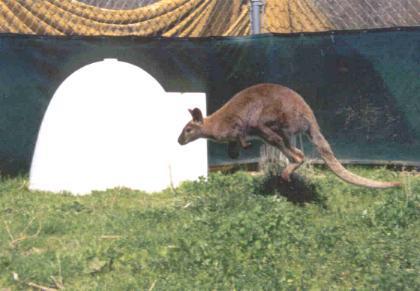Bennett’s Wallabies
Please feel free to call or email if you are interested in placing a deposit on a wallaby and having your name placed on the waiting list. The joeys are sold as they become available in the same order in which I received the deposits. I take a $1500 deposit to place a name on the waiting list. When joeys do become available, beyond deposits received, they will be posted immediately to this page.
Prices are as follows: $3,000 for a female joey plus any shipping expense OR $2500 for a male joey plus any shipping expense.
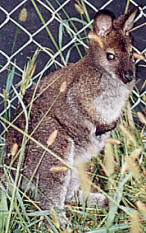 The Bennett’s Wallaby makes a wonderful pet! When bottle raised from infancy and provided with lots of TLC, and plenty of attention, they are capable of returning human affection to a degree astounding to most people! The most common Bennett’s is grayish-red-brown colored with light, almost white under markings and some have black highlight markings. This variety is referred to as a “gray.” A less common variety is the albino Bennett’s which is snow white in color and quite striking in appearance. Besides the color, however, the two are identical in size, behavior, etc. The albino Bennett’s are generally much more expensive however. Valley Exotics raises the “gray” variety. Wallabies are a marsupial which means the infants are born extremely small and crawl into the mother’s pouch where they attach themselves to a nipple. This is where they stay warm and happy until they are some five to seven months of age. At which time they are fully furred and taken to be bottle fed and socialized with humans. Wallabies are also a member of a group of animals called macro pods. A Bennett’s life span is approx. ten to fifteen years. The Bennett’s Wallaby is approx. three feet tall in height and weighs approx. 30 pounds when they reach maturity. Males are generally larger and more muscular, weighing as much as 50 lbs. The height and weight of the species varies considerably from one individual animal to another.
The Bennett’s Wallaby makes a wonderful pet! When bottle raised from infancy and provided with lots of TLC, and plenty of attention, they are capable of returning human affection to a degree astounding to most people! The most common Bennett’s is grayish-red-brown colored with light, almost white under markings and some have black highlight markings. This variety is referred to as a “gray.” A less common variety is the albino Bennett’s which is snow white in color and quite striking in appearance. Besides the color, however, the two are identical in size, behavior, etc. The albino Bennett’s are generally much more expensive however. Valley Exotics raises the “gray” variety. Wallabies are a marsupial which means the infants are born extremely small and crawl into the mother’s pouch where they attach themselves to a nipple. This is where they stay warm and happy until they are some five to seven months of age. At which time they are fully furred and taken to be bottle fed and socialized with humans. Wallabies are also a member of a group of animals called macro pods. A Bennett’s life span is approx. ten to fifteen years. The Bennett’s Wallaby is approx. three feet tall in height and weighs approx. 30 pounds when they reach maturity. Males are generally larger and more muscular, weighing as much as 50 lbs. The height and weight of the species varies considerably from one individual animal to another. 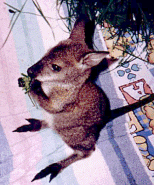 The same is true of the temperament of any individual animal. The attention given a Joey (baby wallaby) from the time he is started on the bottle, the nourishment he receives, his environment, veterinary care, and the age at which he is removed from his mother’s pouch are the most relevant factors in determining his adult disposition and physical condition. Therefore, buying a Joey from a reputable breeder with references is very important. A buyer often gets exactly what he or she pays for! Within reason and current market values that is! “Buyer beware and informed” is advice to be taken seriously! Joeys are commonly kept in babies’ playpens, spending most of their early lives in an artificial pouch which can be made out of flannel material or simply a towel. The pouch can be attached to the side of the playpen with the bottom just off of the floor of the playpen. The Joey will grab the front of the pouch and do a somersault into the pouch! Some owners become creative and design pouches they can wear, taking their furry pets with them wherever they want to go! When a buyer first obtains a Joey from Valley Exotics, he will be furnished with pouch, bottle, marsupial nipples, container of milk, and all the information the buyer needs to keep the Joey healthy and happy! This includes post purchase support. The buyer will continue bottle feeding for a time while introducing a solid food as the Joey becomes older. Valley Exotics uses a baked food which looks similar to popcorn and is called “HAPPY HOPPER.” This food contains all of the essential nutrition a wallaby needs, with proper levels of vitamin E and selenium which are essential to a wallaby’s health. There are other products available specifically for wallabies but we have had good success with “HAPPY HOPPER.” Wallabies also enjoy a variety of fruits and vegetables. Grass for grazing in the summer is necessary as well as quality hay in the winter. A fresh, clean, and constant water supply is also a must. A wallaby can be kept in the home for as long as the first year but an outside enclosure is eventually a necessity, in our opinion. A fence of at least six feet in height is recommended. Some type of screening approx. three feet in height to make the fence clearly visible to the wallaby is also a good idea. This keeps the wallaby from hopping into the fence at high speed which is a common cause of injury or even death. The screen we use is the dark green mesh frequently used on tennis courts. This also keeps any creature such as a dog outside the pen from becoming too interested in the wallaby world inside and attempting to enter it. Wallabies are very susceptible to stress and being chased by the neighbor’s dog is a good way to end-up with a wallaby killed from stress myopathy.
The same is true of the temperament of any individual animal. The attention given a Joey (baby wallaby) from the time he is started on the bottle, the nourishment he receives, his environment, veterinary care, and the age at which he is removed from his mother’s pouch are the most relevant factors in determining his adult disposition and physical condition. Therefore, buying a Joey from a reputable breeder with references is very important. A buyer often gets exactly what he or she pays for! Within reason and current market values that is! “Buyer beware and informed” is advice to be taken seriously! Joeys are commonly kept in babies’ playpens, spending most of their early lives in an artificial pouch which can be made out of flannel material or simply a towel. The pouch can be attached to the side of the playpen with the bottom just off of the floor of the playpen. The Joey will grab the front of the pouch and do a somersault into the pouch! Some owners become creative and design pouches they can wear, taking their furry pets with them wherever they want to go! When a buyer first obtains a Joey from Valley Exotics, he will be furnished with pouch, bottle, marsupial nipples, container of milk, and all the information the buyer needs to keep the Joey healthy and happy! This includes post purchase support. The buyer will continue bottle feeding for a time while introducing a solid food as the Joey becomes older. Valley Exotics uses a baked food which looks similar to popcorn and is called “HAPPY HOPPER.” This food contains all of the essential nutrition a wallaby needs, with proper levels of vitamin E and selenium which are essential to a wallaby’s health. There are other products available specifically for wallabies but we have had good success with “HAPPY HOPPER.” Wallabies also enjoy a variety of fruits and vegetables. Grass for grazing in the summer is necessary as well as quality hay in the winter. A fresh, clean, and constant water supply is also a must. A wallaby can be kept in the home for as long as the first year but an outside enclosure is eventually a necessity, in our opinion. A fence of at least six feet in height is recommended. Some type of screening approx. three feet in height to make the fence clearly visible to the wallaby is also a good idea. This keeps the wallaby from hopping into the fence at high speed which is a common cause of injury or even death. The screen we use is the dark green mesh frequently used on tennis courts. This also keeps any creature such as a dog outside the pen from becoming too interested in the wallaby world inside and attempting to enter it. Wallabies are very susceptible to stress and being chased by the neighbor’s dog is a good way to end-up with a wallaby killed from stress myopathy. 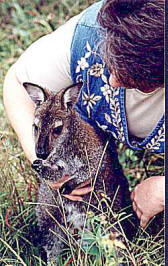 The outside enclosure need not be of enormous size. For one or two wallabies, an area found in an average size back yard is more than sufficient. If owning a mob of wallabies numbering ten or so is your eventual goal, much thought must be given to the size of the enclosure. Wallabies do quite well in a wide range of temperatures and climates. A shelter from the cold such as a Dogloo* or a home made wooden shelter somewhat similar to a dog house is all that is needed in most cases. In extremely cold climates, some people use heat lamps or heat mats on the floor of the shelter. The water supply should be kept fresh and covered in order to prevent contamination from bird droppings which carry disease deadly to wallabies. The food dish or hanging feeder should also be covered. Plenty of shade should be available to wallabies in hot weather. The wallaby is a fun backyard hobby animal and is a great pet! If care is taken to consider all of their needs and you love animals but want something a little more exotic than say a “GOLD FISH”, a Bennett’s Wallaby will bring a great deal of enjoyment to your life for many years!
The outside enclosure need not be of enormous size. For one or two wallabies, an area found in an average size back yard is more than sufficient. If owning a mob of wallabies numbering ten or so is your eventual goal, much thought must be given to the size of the enclosure. Wallabies do quite well in a wide range of temperatures and climates. A shelter from the cold such as a Dogloo* or a home made wooden shelter somewhat similar to a dog house is all that is needed in most cases. In extremely cold climates, some people use heat lamps or heat mats on the floor of the shelter. The water supply should be kept fresh and covered in order to prevent contamination from bird droppings which carry disease deadly to wallabies. The food dish or hanging feeder should also be covered. Plenty of shade should be available to wallabies in hot weather. The wallaby is a fun backyard hobby animal and is a great pet! If care is taken to consider all of their needs and you love animals but want something a little more exotic than say a “GOLD FISH”, a Bennett’s Wallaby will bring a great deal of enjoyment to your life for many years!
